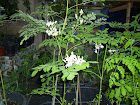In the U.S., more than 2.8 million antimicrobial-resistant infections occur each year! Have you taken a round or two of antibiotics? Have you taken antibiotics for weeks or months? Are you in gut pain as a result? In this article,...
Welcome to Cathryn’s Herbal Health and Wellness blog
Welcome to Cathryn’s Herbal Health and Wellness Blog I have been a healer and herbalist for 24-plus years. Holistic healing begins with your first step and continues for the rest of your life. Living the Inflamation-Free Lifestyle is one of the principles for health. In my blog, I share with Read More
When life knocks you off your feet? Find the silver lining?
When life knocks you off your feet, find the silver lining! Often, after disappointment, we wallow in a pity party. That is ok for a short time but then it is important to dust your attitude off and look for the lessons and silver lining. You must look for the Read More
How to Take Herbs Effectively and Safely.
Learn how to take herbs safely in this article. Are you taking your herbs properly and in the proper dosage? Are you taking the right herb for your health challenge? Did you research the company to see if the products were properly tested? Research your health challenge or illness! The Read More
Does Holistic Medicine Always Work?
Holistic Medicine is a whole different view of a patient and how to treat them than how standard medicine treats patients. Is standard medicine safer and more effective than holistic medicine? The main purpose of the holistic doctor is to find the root cause for symptoms by looking at diet, Read More
What is Orthomolecular Medicine and its Importance?
Orthomolecular medicines’ main goal is to restore the body’s balance both in the brain and bodily functions by correcting imbalances or deficiencies based on each person’s biochemistry. Orthomolecular doctors utilize natural substances such as vitamins, minerals, trace elements, and amino acids to achieve that balanced chemistry. Orthomolecular Medicine was founded Read More
Turmeric and Holistic Cancer Treatment
Learn how Turmeric is used in Asian countries as part of anti-cancer treatment. Among the natural therapies used to treat cancer in every country including Japan, Malaysia, China, Taiwan, the Philippines, and other countries is Turmeric with its main ingredient being curcumin which goes after the cancer cells. This past Read More
Gingko Research Results Confusing. Why?
Why is the research on Gingko and its effectiveness on cognition confusing? You will find studies that support Gingko’s benefits for brain health and studies that report there was no benefit. Why are there such differing research conclusions? Do Alzheimer’s drugs work better? I answer those questions in the second Read More
The Amazing Properties of Neem: Antibiotic and Antiviral

Learn about the amazing properties of Neem tree leaves that contain natural antiviral and antibiotic-potent properties on your path to natural wellness. Neem or Azadirachta indica a. Juss, has been an important plant for its medical properties in Ayurvedic, Unani, and Homeopathic medicine for thousands of years. Neem tree leaves, Read More
Cat’s Claw- Can it Heal Arthritis and Cancer?
Cat’s Claw- Can it Heal Arthritis, Cancer, and Other Diseases? Cat’s Claw is an old herb getting new press and attention. Cat’s Claw is one of 15 of the most popular herbs Americans use. It is also used extensively in Europe. Many call it the ‘Miracle Herb’ from the rain Read More
Lavender : Beauty, Medicine, so many uses!
Lavender is common name for a genus (Lavandula) of fragrant herbs or shrubs of which a Mediterranean subshrub species (L. spica) is grown for ornament in the garden and for its sweet scent when dried. The dried flowers are used to fill sachets and to perfume clothing or linens. Commercially Read More
Lemon Balm (melissa officinalis)
Lemon Balm (Melissa officinalis), an aromatic, sweet herb of the Mint Family grown in the herb garden for seasoning, and also used in liqueurs and historically, as a medicine. It grows to 2 feet tall and has small 2-lipped flowers in late summer, and leaves of a decided lemon odor Read More
Alma Berries Super Food for Longevity
Alma Berries- Learn About this Exotic Fruit from India that Acts as a Super Food for Longevity. Alma berries are a food to improve your health and longevity containing Vitamin C, and many of the trace minerals we are lacking today. Do you want to eat food to help prevent Read More
Six Steps to take Including Ashwagandha for Insomnia!
Six Steps to take Including Ashwagandha for Insomnia! Learn about six steps you can implement today to end your insomnia and improve the quality of your sleep and health. Anxiety and sleep issues are two of the biggest problems in today’s stress-filled world. Ashwagandha is an Ayurvedic herb that may Read More
Designer Turmeric Golden Milk
The Turmeric Golden Milk Drink is for health and a strong immune system. It is an anti-inflammatory drink that is soothing as well. It is Ayurvedic in origin but has become popular in America now. In making the Golden Milk Drink you include milk or various alternative milk substitutes, turmeric, Read More
Adaptogen Herbs Boost Immune Function
Adaptogen Herbs Help You To Resist Infections, Viruses, and Bacterial Infections and Boost Your Immune Function. Adaptogen herbs are considered tonic herbs. Adaptogen herbs are taken in addition to improving your negative health factors such as a junk food diet, lack of sleep, lack of exercise, smoking, and drinking. Over Read More
Medicinal Mushrooms for Awesome Health Benefits
Learn today how medicinal mushrooms help boost your immune system and disease resistance. Mushrooms have been used for centuries and are one of the important keys to longevity. I discovered mushrooms late in life. It wasn’t until my traditional go-to herbs did not work for me with an infected jawbone Read More
Why Doctors and Scientists Reject Published Herb Research Studies
Why Doctors and Scientists Reject Published Herb Research Studies Posted on February 10, 2023 by herbladyisin Why do doctors reject published herb research from other countries? Learn Why You Will Never Get Exact and Consistent Published herb Research Studies. It is the fundamental difference between drugs and herbs. You cannot compare published Read More
Join my Lyme Support Group on MeWe
Join my Lyme Support Group on MeWe below! This week I began a group on MeWe for people who have Lyme or Lyme co-infections or have Chronic or late-stage Lyme. This group will be there to support each other and to learn about resources and treatments that may be Read More
Learn How to Repair Your Gut After Antibiotics!
In the U.S., more than 2.8 million antimicrobial-resistant infections occur each year! Have you taken a round or two of antibiotics? Have you taken antibiotics for weeks or months? Are you in gut pain as a result? In this article, find out what antibiotic side effects do to your gut Read More
Andrographis Paniculata For Colds, Flu, Viruses
Andrographis paniculata is one of the most effective Ayurvedic herbs for Colds, flu and so much more. It is also known as “Indian echinacea and Kalmegh”. It is the king of bitters, even surpassing Goldenseal. You can smell the bitterness when you work with the raw herb. It has Read More
Cooking with Medicinal Mushrooms
Cooking with medicinal mushrooms is one of the healthiest changes you can make to your diet for overall brain and immune system health. If you are not using medicinal mushrooms now, you should be. Cooking with medicinal mushrooms is easy and this article will give ideas to begin today. Read More
Herbs Of the Bible, Faith, and Prayer
It’s 2024, and the world seems in constant upheaval. I am introducing a new series of blogs on herbs of the bible, faith, prayer, and being an empath. Once a week, I will be writing on faith and healing, principles of healthy living that are found in the bible. You Read More
Antiviral and Antimicrobial Herbs for Colds, Flu, and Infections
How many times have you been sick with colds and flu lately? Losing work? Sick of being sick? Learn about antiviral and antimicrobial herbs that help you stay healthy during this cold and flu season. In our small town, many people are getting sick with seasonal colds, flu, and infections. Read More
Improve Memory and Focus with Food and Herbs
Every time I search the headlines, I see articles daily on improving memory and focus, dementia, Alzheimer’s, and early-onset dementia. It is a hot topic and should be. If you don’t have a sharp memory, every aspect of your life is impacted devastatingly. Our lifestyle habits can make a huge Read More
How to Conquer Brain and Memory Problems with Diet
How to Conquer Brain and Memory Problems with Diet! This new year work on improving your health including your brain and memory function. There should be no excuses. Without great memory function, you can not perform your job or be effective at home with your children and family. You cannot Read More
Horrible Head Pressure and Weird Head Sensations: test for Babesia
Horrible head pressure and weird head sensations are some of the symptoms of the Lyme disease co-infection Babesiosis which is caused by the Babesia parasite. Babesia is a malaria-like parasite, also called a “piroplasm,” that infects red blood cells. Your family asks you if you have a headache but it Read More
When ALS, MS, TM and Mental Illness Is Really Lyme Disease
ALS, MS, Dementia, and Mental Illness are diseases that destroy the lives of thousands of people in the US and the world. LYME Literate doctors are finding that many patients given these horrible diagnoses such as ALS, when tested by IGenex with a full co-infection panel for Lyme co-infections, are Read More
Basal Cell Cancer Surgery Complications
Basal cell cancer surgery complications: What your Doctor Doesn’t Tell You that may impact your life. Basal cell skin cancers are usually the least lethal in terms of death and spreading into organs such as the brain and lungs. Saying that they are ignored, misdiagnosed, and treated like they are Read More
Basal Cell Carcinoma Dangers
Basal Cell Carcinoma Dangers if Left Untreated can be severe and dangerous. I know this from experience. It was only in October of this year 2023 that I went to the dermatologist about a tick bite that had never healed over the past 4 years. For more than a year Read More
Tick Bite Treatments: My Tick Bite Won’t Heal!
Tick Bite Treatments: My Tick Bite Won’t Heal! It’s been months or several years and it still itches and hurts! Why it’s important to have it looked at by a dermatologist? My personal story of a tick bite that NEVER healed turned into basal cell carcinoma. Can a tick bite Read More
Kris Kristofferson, Famous People, and Undiagnosed Lyme Disease
This article today is about famous actors and singers whose life has been nearly destroyed by Undiagnosed Lyme Disease. It is to show that Undiagnosed Lyme disease is a critical issue in every segment of our society. The fact that even famous people go months and years without a proper Read More
Undiagnosed Childhood Lyme Disease
Undiagnosed Childhood Lyme Disease There may be thousands of children with undiagnosed childhood Lyme disease. There are no accurate numbers but if there are many thousands of adults who go undiagnosed, there are thousands of children in the same boat. Children often don’t pay attention when they are playing. Many Read More
Lewy Body Dementia Symptoms

Robin Williams suffered from Lewy Body Dementia. My husband and I watched one of Robin Williams’s last films produced about 2 years before he committed suicide. It was determined after death he suffered from Lewy Body Dementia. The movie on Amazon Prime is called The Angriest Man in Brooklyn. It Read More
Herb Supplement Quality- Choosing a high-quality supplement.

Herb supplement quality determines how effective the formula is and its safety! Learn how to choose a quality supplement and know you are buying an effective product. That ‘quality’ factor is the most important factor and the most difficult to research because often labels don’t tell you much. Laws Read More
Nematode Parasites and Lyme Disease
Nematode Parasites and Lyme Disease No, I can’t have worms! Nematode Parasites? Where would I have gotten them? Nematode parasites are the elephant in the room that no one wants to look at when treating Lyme Disease. We think about parasite problems in 3rd world countries. Right? Not here Read More
Babesiosis Tick Disease Co-Infection on The Rise?
Why is Babesiosis, one of the many tick-co-infections on the rise? Babesiosis is caused by protozoal parasite, Babisia microti or its cousins. It is not a bacterial infection like the other Lyme co-infections. Malaria is also a protozoal parasite and there are similar symptoms. The difference is Malaria is passed Read More
New Lyme documentary comes to video-on-demand
New Lyme documentary comes to video-on-demand A new Lyme disease documentary, I’m not crazy, I’m sick, will be released via paid video-on-demand on May 30. Reports Variety.com: “The project follows three families, as well as WNBA star Elena Delle Donne, battling the disease and the eye-popping costs that treatment and diagnoses impose on patients. Read More
We Are NOT Lyme Disease!
We are NOT Lyme Disease! You can Overcome its Impact on your health! For many of us who have Chronic Lyme Disease, this multisystem disease takes over so many aspects of our life that we begin to forget who we are. You cannot overcome Lyme Disease until you change Read More